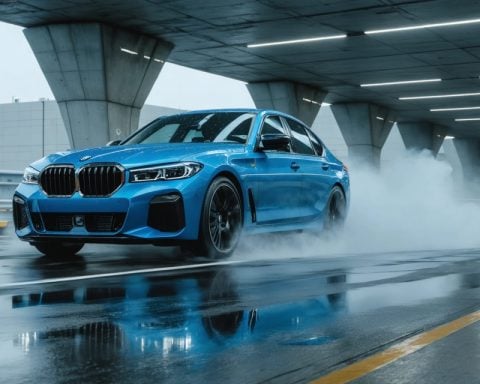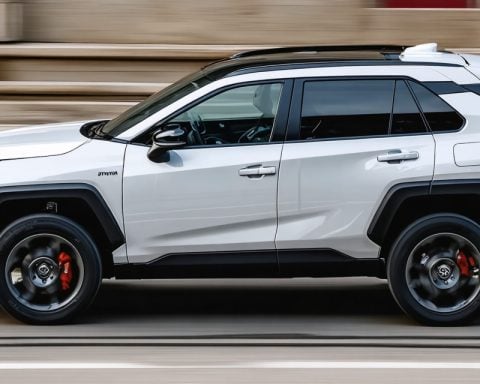GM’s Bold Step into Luxury Electric Vehicles
General Motors is aiming to capture a larger slice of the luxury electric vehicle (EV) segment with the launch of its upgraded Cadillac Lyriq-V SUV. This enticing new model enters a market already characterized by an average EV price exceeding $50,000, raising questions about the sustainability of even higher price points.
Starting at a steep $80,000, the Lyriq-V isn’t exactly a budget-friendly option. However, as the luxury EV market expands, higher price tags seem to attract buyers seeking premium features. A former chief economist at GM highlighted that among the EV offerings for the 2024 model year, over 30 vehicles fall into the luxury category compared to only around 20 that are more affordable.
Part of the appeal lies in cost savings over time. With rising gasoline prices, EV owners can potentially save between $1,000 and $1,200 annually by opting for electric charging instead of traditional fuel. Additionally, premium models typically offer extended battery ranges.
However, experts indicate a limit to how much consumers are willing to invest. The head of insights at Edmunds noted that EVs priced at $100,000 or more represent a very small segment of the overall market, likely accounting for less than 1% of all vehicle sales. As appealing as they might be, luxury EVs face challenges that might prevent them from flying off the shelves.
The Implications of GM’s Luxury EV Strategy
General Motors’ foray into the luxury electric vehicle market with the Cadillac Lyriq-V raises significant questions about the intersection of technology, culture, and global economic trends. As consumer preferences evolve towards sustainability, GM’s strategy exemplifies a broader shift in the automotive industry towards electrification and premium design. This shift does not merely cater to affluent buyers but also addresses growing environmental concerns, as EVs typically produce lower emissions than their gasoline counterparts.
The luxury EV segment could catalyze societal changes as well. As wealthier consumers adopt electric vehicles, their visibility could accelerate broader cultural acceptance of EV technology, encouraging middle-class consumers to make the switch. This phenomenon may fuel a ripple effect, prompting manufacturers across the spectrum to invest more heavily in sustainable technologies and competitive pricing.
From an economic perspective, the luxury EV market represents a lucrative opportunity as global demand for electric vehicles soars. With the International Energy Agency projecting that over 230 million EVs could be on roads by 2030, companies like GM must balance price with production efficiency and supply chain resilience to meet this demand sustainably.
However, the environmental implications cannot be disregarded. The mining of materials for electric batteries poses ecological risks, and the industry faces pressure to ensure that sourcing practices do not compromise sustainability goals. As further innovations unfold, such as battery recycling technologies, the long-term significance of luxury EVs may very well hinge on how well automakers navigate these challenges while appealing to an increasingly discerning consumer base.
The Luxury Electric Revolution: GM’s Cadillac Lyriq-V and the EV Market Trends
GM’s Bold Step into Luxury Electric Vehicles
General Motors (GM) is making a significant push into the luxury electric vehicle (EV) market with the introduction of its upgraded Cadillac Lyriq-V SUV. Priced at around $80,000, the Lyriq-V enters a competitive arena, where the average price of electric vehicles exceeds $50,000. This trend raises important questions about consumer willingness to embrace increasingly higher price tags for premium features and cutting-edge technology.
Market Trends and Insights
In response to the rapidly evolving EV landscape, the luxury segment is expanding. For the 2024 model year, there are over 30 luxury EVs available, in contrast to approximately 20 budget-friendly models. This shift points to a growing segment of consumers ready to invest in high-end electric vehicles, driven by the allure of advanced technology, sustainability features, and a desire for exclusivity.
Pros and Cons of Luxury EVs
Pros:
– Long-term Savings: Owners of luxury EVs can save between $1,000 and $1,200 annually by switching from gasoline to electric charging, especially with soaring fuel prices.
– Superior Technology and Features: Luxury models typically come equipped with the latest innovations such as advanced driver assistance systems, enhanced battery performance, and top-tier infotainment systems.
Cons:
– High Initial Cost: With starting prices around $80,000, luxury EVs may be prohibitive for a significant portion of the consumer market.
– Limited Market Segment: Vehicles priced at $100,000 or more comprise less than 1% of all vehicle sales, reflecting a niche market with limited demand.
Specifications and Unique Features of the Cadillac Lyriq-V
The Cadillac Lyriq-V is positioned to distinguish itself with several impressive specifications:
– All-Electric Range: Expected to offer an extended range compared to traditional fuel-operated vehicles.
– Performance Metrics: Anticipated to feature high-performance metrics that rival other luxury SUVs within the segment.
– Innovative Charging Solutions: Incorporation of advanced fast-charging capabilities, enhancing user convenience.
Use Cases and Consumer Profiles
The Lyriq-V mainly targets affluent, environmentally conscious buyers seeking a blend of luxury and sustainability. Ideal consumers include tech-savvy customers who prioritize modern features and are willing to invest in an electric vehicle as a status symbol.
Pricing and Future Predictions
As the luxury EV market diversifies, manufacturers are likely to introduce models at varying price points to attract a broader audience. Industry analysts predict that while luxury EV sales might initially grow, they will stabilize as more affordable options emerge, creating a balanced market catering to both high-end and budget-conscious consumers.
Innovations and Sustainability Aspects
General Motors is not only focusing on luxury but also committing to sustainability in its manufacturing processes. The company has made significant advancements in battery technology and sourcing materials responsibly, ensuring that its electric vehicle production aligns with environmental sustainability goals.
Conclusion
GM’s Cadillac Lyriq-V represents both a bold step into the luxury EV market and a reflection of broader trends within the automotive industry. As the landscape evolves, it will be fascinating to see how consumers respond to the unique blend of luxury, performance, and sustainability that new electric vehicles offer.
For more information on luxury electric vehicles and GM’s initiatives, visit GM.













